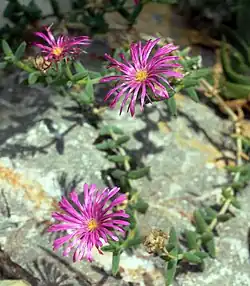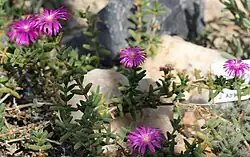Trichodiadema barbatum
| Trichodiadema barbatum | |
|---|---|

| |
| Scientific classification | |
| Kingdom: | Plantae |
| Clade: | Tracheophytes |
| Clade: | Angiosperms |
| Clade: | Eudicots |
| Order: | Caryophyllales |
| Family: | Aizoaceae |
| Genus: | Trichodiadema |
| Species: | T. barbatum
|
| Binomial name | |
| Trichodiadema barbatum | |
| Synonyms[2] | |
|
List
| |
Trichodiadema barbatum is succulent plant of the genus Trichodiadema, native to the Eastern Cape Province, South Africa.[3]
Description
.jpg)

A small, gracile, erect-to-decumbent plant, with long, slender, fragile, stick-like branches. The internodes are minutely papillate; On young branches the internodes are green, becoming grey on older branches.[4]
The grey-green leaves are slightly triangular in cross-section, and have large bladder cells on their leaf-surface. Bristles (5-7) emerge from the dark tip of the leaf.
The solitary, bright pink-to-purple flowers are born on long pedicels. They have petals with slightly notched apices, small pale filamentous staminodes, and yellow anthers.
The fruit capsule is 5-locular, like that of Trichodiadema burgeri (but unlike some other species in the genus, such as Trichodiadema densum and Trichodiadema marlothii.[5][6]
It has gained the Royal Horticultural Society's Award of Garden Merit.[7]
References
- ^ Z. Sukkulentenk. 2: 188 (1926)
- ^ "Trichodiadema barbatum (L.) Schwantes". Plants of the World Online. Board of Trustees of the Royal Botanic Gardens, Kew. 2017. Retrieved 29 November 2020.
- ^ SANBI Red List page
- ^ H.E.K. Hartmann. (2017). Illustrated Handbook of Succulent Plants: Aizoaceae F-Z. Springer Verlag
- ^ I.M. Niesler (2017). Trichodiadema Ruschioideae. In: Hartmann H. (eds) Aizoaceae. Illustrated Handbook of Succulent Plants. Springer, Berlin, Heidelberg: 341
- ^ H.E.K. Hartmann and I.M. Niesler. (2013). A new morphological study of the genus Trichodiadema (Aizoaceae) permits the description of a new subgenus, t. subg. Gemiclausa. Bradleya 31:58-75.
- ^ "Trichodiadema barbatum". The Royal Horticultural Society. Retrieved 29 November 2020.